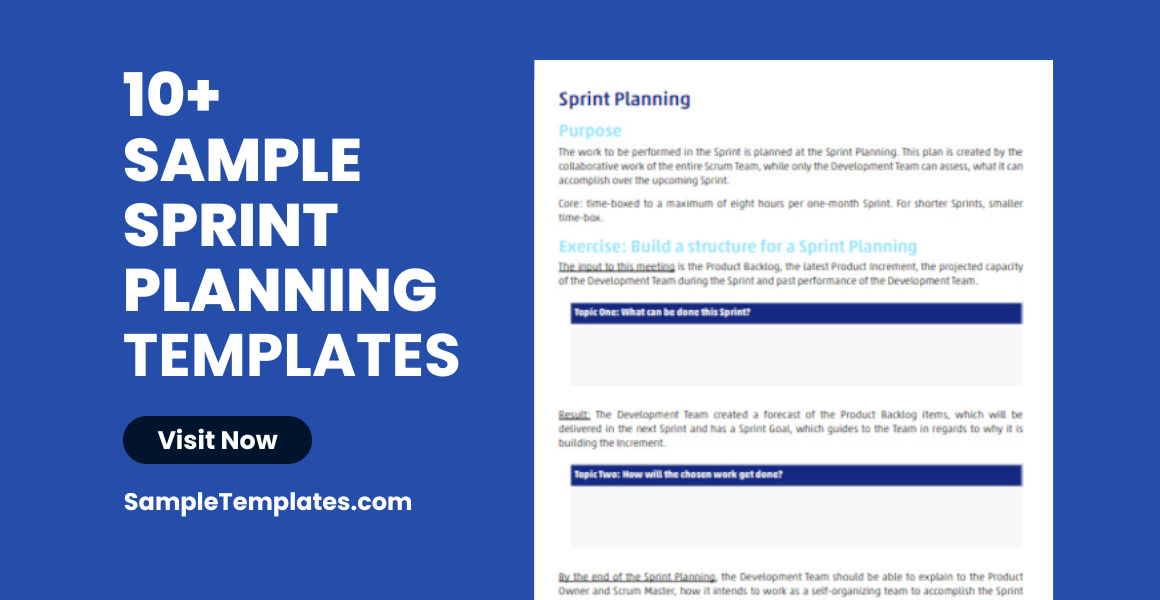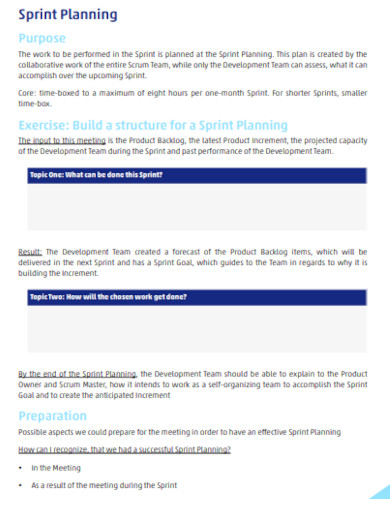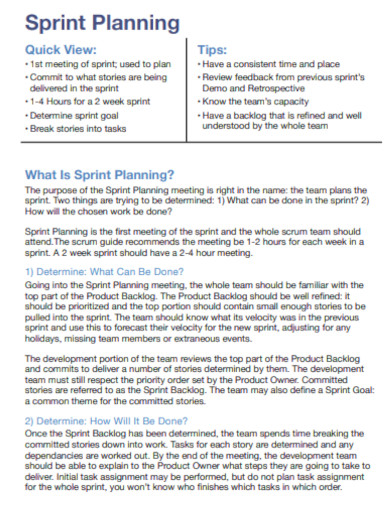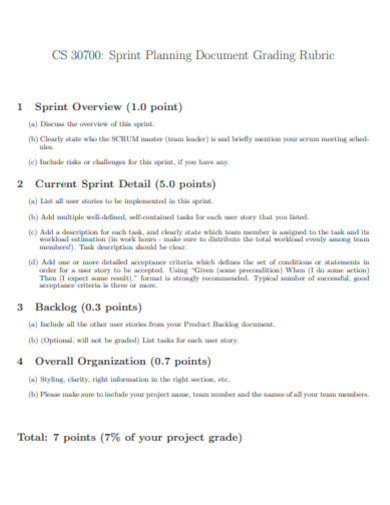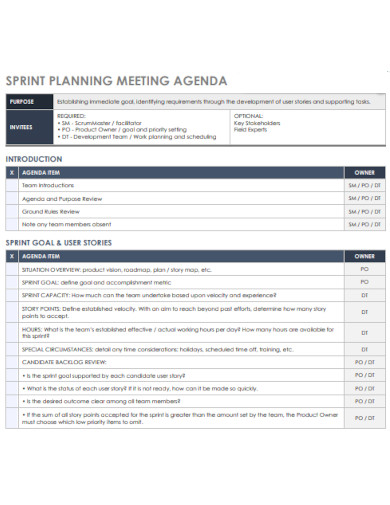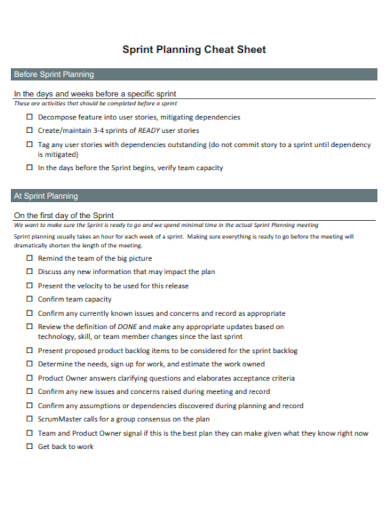Embark on a journey of efficient project management with Sprint Planning, the cornerstone of Agile methodology. This strategic approach empowers teams to deliver high-quality projects with precision. Dive into the world of Sprint Planning, where meticulous timelines, goal-oriented tasks, and collaborative team efforts converge to set the stage for a successful project sprint. Unlock the potential of your team with our expertly crafted templates and guides, designed to streamline your sample planning process and enhance productivity.
10+ Sprint Planning Samples
1. Sample Sprint Planning Template
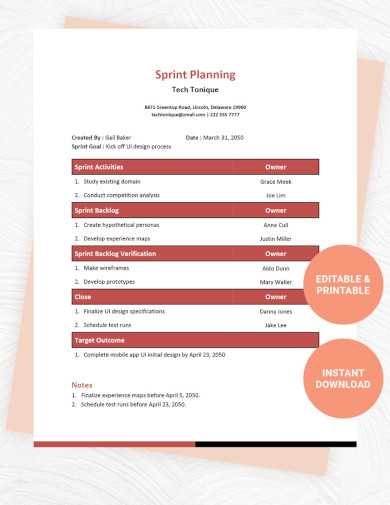
2. Sample Sprint Planning Dashbaord Template
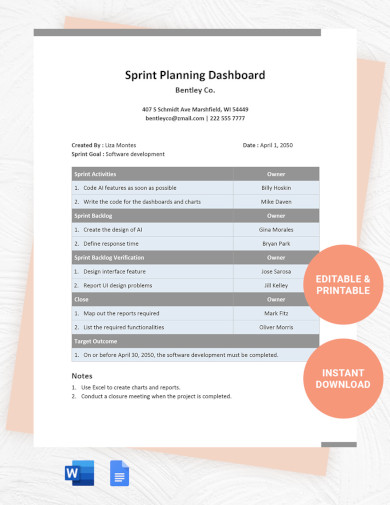
3. Sample Sprint Planning Board Template
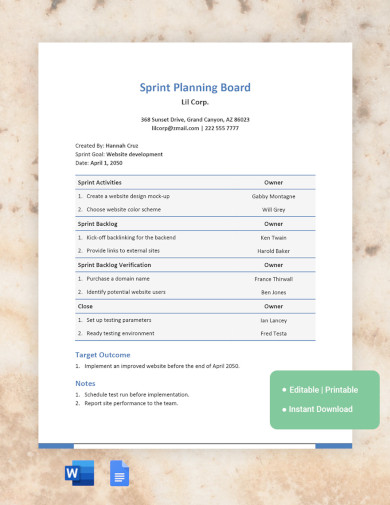
4. Sample Marketing Sprint Planning Template

5. Sample Scrum Sprint Planning Template

What is Sprint Planning?
Sprint planning is a critical phase in the Scrum framework, an agile methodology used to develop, deliver, and sustain complex projects. This sample event marks the start of the sprint by setting the foundation and direction for all the work to be carried out during the sprint.
Understanding the Purpose of Sprint Plan
ning
The primary goal of sprint planning is to define what can be delivered in the sprint and how that work will be achieved. It involves the collaborative effort of the entire Scrum Team—Scrum Master, Product Owner, and Developers.
Key Participants in Sprint Planning
- Scrum Master: Facilitates the meeting and ensures that the process is followed.
- Product Owner: Represents the stakeholders and the voice of the customer, providing the team with the product backlog items that have the highest priority.
- Development Team: Determines the technical feasibility and the tasks necessary to complete the chosen backlog items.
The Process of Sprint Planning
Sprint planning typically involves two main areas of focus:
- What to Build: The Product Owner presents the prioritized product backlog items to the team, aiming to achieve the sprint goal.
- How to Build It: Once the items are selected, the Development Team sample plans the work necessary to create a working increment of the product.
Setting the Sprint Goal
The sprint goal is an objective set during sprint sample planning that is to be met within the sprint through the implementation of the product backlog. It provides guidance to the Development Team on why it is building the increment.
Determining the Sprint Backlog
The sprint backlog is a list of everything that the Scrum Team commits to achieving in a sprint. It is a forecast by the Development Team about what functionality will be in the next increment and the work needed to deliver that functionality into a “Done” increment.
Duration and Timing of Sprint Planning
Sprint planning is time-boxed to a maximum of eight hours for a one-month sprint. For shorter sprints, the event is usually shorter.
The Outcome of Sprint Planning
By the end of sprint planning, the team should have a sprint backlog that details the tasks to be completed during the sprint, a sprint goal that aligns the team’s work, and a clear vision of the expected product increment.
Best Practices for Effective Sprint Planning
- Preparation: The Product Owner should have a well-groomed product backlog before sprint planning begins.
- Collaboration: It’s essential for the team to work together to understand the work and agree on the sprint plan.
- Realistic Commitment: The team should only commit to what they can complete within the sprint.
- Flexibility: While the sprint goal should not change, the team should be open to renegotiating the scope with the Product Owner as more is learned. You can also see more templates like Agile Sprint Plans.
Challenges in Sprint Planning
- Overcommitment: Teams may feel pressured to take on more than they can realistically deliver.
- Vague Goals: Without a clear sprint goal, the team may lack direction.
- Insufficient Detail: Failing to break down tasks can lead to misunderstandings and incomplete increments.
What are the Phases of Sprint Planning?
Sprint planning is a critical phase in the Agile project management methodology, particularly within the Scrum framework. It’s a collaborative effort involving the Scrum team: the product owner, the Scrum Master, and the development team. This meeting’s primary goal is to define what can be delivered in the sprint and how that work will be achieved. Let’s delve into the phases of sprint planning to ensure your team’s success.
Establishing the Sprint Goal
Before diving into the specifics, it’s essential to set a clear and achievable sprint goal. This goal is a concise statement that sample outlines the intended outcome of the sprint. It provides guidance and a sense of purpose, ensuring that the team remains focused and aligned throughout the sprint.
The Product Owner’s Role: Prioritizing the Backlog
The product owner plays a pivotal role in sprint planning by prioritizing the product backlog. This curated sample list of project tasks and requirements is the foundation from which the team selects work for the sprint. Prioritization is based on various factors, including business value, stakeholder needs, and the overall strategic plan.
Capacity Planning: Assessing the Team’s Bandwidth
An honest assessment of the development team’s capacity is crucial. This involves considering the team’s availability and any potential impediments that could affect the sprint. By doing so, the team can commit to a realistic and manageable workload.
Selecting the Sprint Items
With the sprint goal in mind and an understanding of the team’s capacity, the next step is to select items from the product backlog to include in the sprint. These items should align with the sprint goal and be sized appropriately to fit within the team’s capacity.
Task Breakdown and Assignment
Once the items are selected, the team breaks them down into specific tasks. This detailed planning makes the work manageable and transparent, allowing for better tracking and adjustment throughout the sprint. Tasks are then assigned to team members, taking into account individual skills and experience.
Formulating a Sprint Strategy
Developing a plan of strategy for how the team will approach the work is a collaborative effort. This includes discussing dependencies, potential challenges, and the technical approach to be taken. The strategy should be flexible enough to accommodate changes without derailing the sprint.
Risk Identification and Mitigation
Identifying potential risks early on is a proactive step in sprint planning. The team discusses what could go wrong and how these risks can be mitigated. This foresight helps in maintaining the sprint’s momentum and achieving the sprint goal.
Finalizing the Sprint Plan
The culmination of sprint planning is the finalization of the sprint plan. This sample plan includes the sprint backlog, which is the list of items the team has committed to, and a clear definition of what constitutes a successful sprint. The plan acts as a contract and a guide for the team.
Review and Adaptation
While not always considered a formal phase, reviewing and adapting the plan is an implicit part of sprint planning. Agile is about flexibility and learning. As the sprint progresses, the team should be prepared to review their progress and adapt their plan to ensure the sprint goal is met.
How is Sprint Planning Structured?
Sprint planning is a cornerstone activity in Agile methodologies that sets the stage for a successful sprint. It is structured to maximize collaboration, clarity, and commitment from the entire Scrum team. Here’s how a typical sprint planning session is structured to ensure that the team is ready to embark on the sprint with a clear plan of action.
Opening the Session: Setting the Stage
The sprint planning session begins with the Scrum Master facilitating the meeting. The Scrum Master ensures that the meeting’s purpose and sample agenda are clear to everyone involved. This initial stage is crucial for setting expectations and reiterating the sprint’s duration and objectives.
Sprint Goal Definition
The product owner presents the prioritized product backlog items (PBIs) and proposes a sprint goal. This goal is a high-level summary of what the sprint should achieve and acts as the guiding light for the team’s efforts during the sprint.
Team Capacity Review
The development team reviews their capacity for the upcoming sprint. This includes discussing team members’ availability, holidays, and other commitments that could impact the sprint’s workload. Understanding capacity is vital to ensure that the team does not overcommit.
Backlog Grooming and Item Selection
The team, along with the product owner, then grooms the product backlog. They discuss the details of each item, clarify any ambiguities, and ensure that everyone has a shared understanding of what is required. The team selects items from the top of the product backlog that they can commit to completing within the sprint, based on their capacity.
Task Breakdown and Effort Estimation
Once the PBIs are selected, the team breaks them down into tasks. Each task is discussed in terms of what needs to be done, and effort estimations are made. This granular view of the sprint work helps in understanding the scope and complexity of the work ahead.
Resource Allocation and Task Assignment
With tasks defined and estimated, the team discusses who will work on what. Task a general assignments are made based on team members’ skills, interests, and development needs. This collaborative approach ensures that all team members are engaged and committed to the sprint tasks.
Identification of Dependencies and Risks
The team identifies any dependencies between tasks or external factors that could impact the sprint. They also discuss potential risks and devise strategies for mitigating them. This proactive approach helps in managing uncertainties and keeping the sprint on track.
Commitment and Plan Finalization
The final step in sprint planning is for the team to commit to the work they have planned. The sprint backlog is finalized, and the team agrees on a sprint plan that outlines how the work will be approached. This plan includes the tasks, assignments, and any identified risks and dependencies.
Closing the Session: Recap and Confirmation
The Scrum Master ensures that everyone leaves the meeting with a clear understanding of the sprint plan. The session closes with a recap of the sprint goal, the committed backlog items, and the plan for achieving them. The team confirms their commitment, and the sprint planning is concluded.
Continuous Review and Adaptation
While not a formal part of the sprint planning meeting, it’s important to note that Agile teams should continuously review and adapt their documentation plan throughout the sprint. This agility allows the team to respond to changes and ensure that they are always working towards the sprint goal.
6. Sample Software Development Sprint Planning
7. Sample Sprint Planning Checklist Template
8. Sample Sprint Planning Document
9. Sample Sprint Planning Template
10. Sample Sprint Planning Meeting Agenda
11. Sample Sprint Planning Cheat Sheet Template
How to Plan a Sprint?
1. Sprint Goal Definition:
- Begin by defining a sprint goal that aligns with the product roadmap and provides a clear objective for the sprint.
2. Review Backlog and Performance:
- The product owner reviews the product backlog items (PBIs) with the team, ensuring they are well-defined and prioritized.
- The team reviews their performance in past sprints to inform their planning.
3. Capacity Assessment:
- Assess the available capacity of the team for the upcoming sprint, taking into account holidays, planned absences, and other commitments.
4. Select Backlog Items:
- Based on the sprint goal and team capacity, select the top-priority PBIs from the product backlog for inclusion in the sprint.
5. Breakdown and Estimate:
- Break down PBIs into smaller, manageable tasks and estimate the effort required for each task.
6. Task Assignment:
- Assign tasks to team members, considering individual skills, experience, and workload balance.
7. Risk Analysis:
- Identify potential risks and impediments that could impact the sprint and discuss strategies for mitigation.
8. Sprint Backlog Creation:
- Create a sprint backlog that includes all tasks and PBIs committed to for the sprint.
9. Commitment:
- The team collectively commits to the sprint plan, confirming that the selected PBIs and tasks are achievable within the sprint.
10. Sprint Planning Review:
- Review the sprint plan with the entire team to ensure understanding and agreement.
11. Adaptation Plan:
- Establish a process for monitoring progress and adapting the sprint plan as needed during the sprint.
What Is the Goal of Sprint Planning?
The goal of sprint planning is to define what can be delivered in the upcoming sprint and determine how the work will be achieved, ensuring the team has a clear plan and shared understanding of the objectives for the sprint period.
What Are the Inputs to Sprint Planning?
The inputs to sprint planning include the product backlog, the latest product increment, the projected capacity of the development team for the sprint, and any past performance metrics of the team.
In Conclusion, sprint planning is a vital event in the Scrum process that sets the stage for a successful sprint. It requires careful consideration, collaboration, and commitment from the entire Scrum Team. When done correctly, it leads to a clear plan of action and a shared understanding of the goals and tasks for the upcoming sprint.
Related Posts
FREE 7+ Fashion Business Plan Samples in PDF
FREE 10+ Wedding Planning Samples in MS Word | Apple Pages | Powerpoint | PDF
FREE 9+ Monthly Study Planner Samples in PSD | Illustrator | InDesign | PDF
FREE 9+ Sample Curriculum Planning Templates in PDF | MS Word
FREE 10+ Teacher Development Plan Samples in MS Word | Google Docs | Apple Pages | PDF
FREE 10+ Basketball Practice Plan Samples in PDF
FREE 12+ School Business Plan Samples in PDF | MS Word | Apple Pages | Google Docs
FREE 7+ Client Strategic Plan Samples in PDF | MS Word
FREE 11+ Trucking Business Plan Templates in PDF | MS Word | Google Docs | Pages
FREE 7+ Small Hotel Business Plan Samples PDF | MS Word | Apple Pages | Google Docs
FREE 14+ Bakery Business Plans in MS Word | PDF | Google Docs | Pages
FREE 4+ Yearly Lesson Plan Samples in PDF
FREE 50+ Strategic Planning Samples in Google Docs | Pages | PDF | MS Word
FREE 10+ Construction Project Plan Samples in MS Word | Google Docs | Apple Pages | PDF
FREE 10+ Construction Marketing Business Plan Samples in MS Word | Google Docs | PDF
